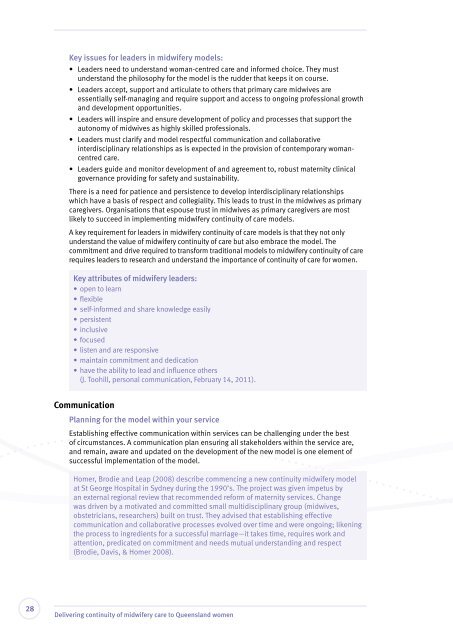Delivering continuity of midwifery care to Queensland women
Delivering continuity of midwifery care to Queensland women
Delivering continuity of midwifery care to Queensland women
You also want an ePaper? Increase the reach of your titles
YUMPU automatically turns print PDFs into web optimized ePapers that Google loves.
Key issues for leaders in <strong>midwifery</strong> models:<br />
• Leaders need <strong>to</strong> understand woman-centred <strong>care</strong> and informed choice. They must<br />
understand the philosophy for the model is the rudder that keeps it on course.<br />
• Leaders accept, support and articulate <strong>to</strong> others that primary <strong>care</strong> midwives are<br />
essentially self-managing and require support and access <strong>to</strong> ongoing pr<strong>of</strong>essional growth<br />
and development opportunities.<br />
• Leaders will inspire and ensure development <strong>of</strong> policy and processes that support the<br />
au<strong>to</strong>nomy <strong>of</strong> midwives as highly skilled pr<strong>of</strong>essionals.<br />
• Leaders must clarify and model respectful communication and collaborative<br />
interdisciplinary relationships as is expected in the provision <strong>of</strong> contemporary womancentred<br />
<strong>care</strong>.<br />
• Leaders guide and moni<strong>to</strong>r development <strong>of</strong> and agreement <strong>to</strong>, robust maternity clinical<br />
governance providing for safety and sustainability.<br />
There is a need for patience and persistence <strong>to</strong> develop interdisciplinary relationships<br />
which have a basis <strong>of</strong> respect and collegiality. This leads <strong>to</strong> trust in the midwives as primary<br />
<strong>care</strong>givers. Organisations that espouse trust in midwives as primary <strong>care</strong>givers are most<br />
likely <strong>to</strong> succeed in implementing <strong>midwifery</strong> <strong>continuity</strong> <strong>of</strong> <strong>care</strong> models.<br />
A key requirement for leaders in <strong>midwifery</strong> <strong>continuity</strong> <strong>of</strong> <strong>care</strong> models is that they not only<br />
understand the value <strong>of</strong> <strong>midwifery</strong> <strong>continuity</strong> <strong>of</strong> <strong>care</strong> but also embrace the model. The<br />
commitment and drive required <strong>to</strong> transform traditional models <strong>to</strong> <strong>midwifery</strong> <strong>continuity</strong> <strong>of</strong> <strong>care</strong><br />
requires leaders <strong>to</strong> research and understand the importance <strong>of</strong> <strong>continuity</strong> <strong>of</strong> <strong>care</strong> for <strong>women</strong>.<br />
Key attributes <strong>of</strong> <strong>midwifery</strong> leaders:<br />
• open <strong>to</strong> learn<br />
• flexible<br />
• self-informed and share knowledge easily<br />
• persistent<br />
• inclusive<br />
• focused<br />
• listen and are responsive<br />
• maintain commitment and dedication<br />
• have the ability <strong>to</strong> lead and influence others<br />
(J. Toohill, personal communication, February 14, 2011).<br />
Communication<br />
Planning for the model within your service<br />
Establishing effective communication within services can be challenging under the best<br />
<strong>of</strong> circumstances. A communication plan ensuring all stakeholders within the service are,<br />
and remain, aware and updated on the development <strong>of</strong> the new model is one element <strong>of</strong><br />
successful implementation <strong>of</strong> the model.<br />
Homer, Brodie and Leap (2008) describe commencing a new <strong>continuity</strong> <strong>midwifery</strong> model<br />
at St George Hospital in Sydney during the 1990’s. The project was given impetus by<br />
an external regional review that recommended reform <strong>of</strong> maternity services. Change<br />
was driven by a motivated and committed small multidisciplinary group (midwives,<br />
obstetricians, researchers) built on trust. They advised that establishing effective<br />
communication and collaborative processes evolved over time and were ongoing; likening<br />
the process <strong>to</strong> ingredients for a successful marriage—it takes time, requires work and<br />
attention, predicated on commitment and needs mutual understanding and respect<br />
(Brodie, Davis, & Homer 2008).<br />
28<br />
<strong>Delivering</strong> <strong>continuity</strong> <strong>of</strong> <strong>midwifery</strong> <strong>care</strong> <strong>to</strong> <strong>Queensland</strong> <strong>women</strong>
















